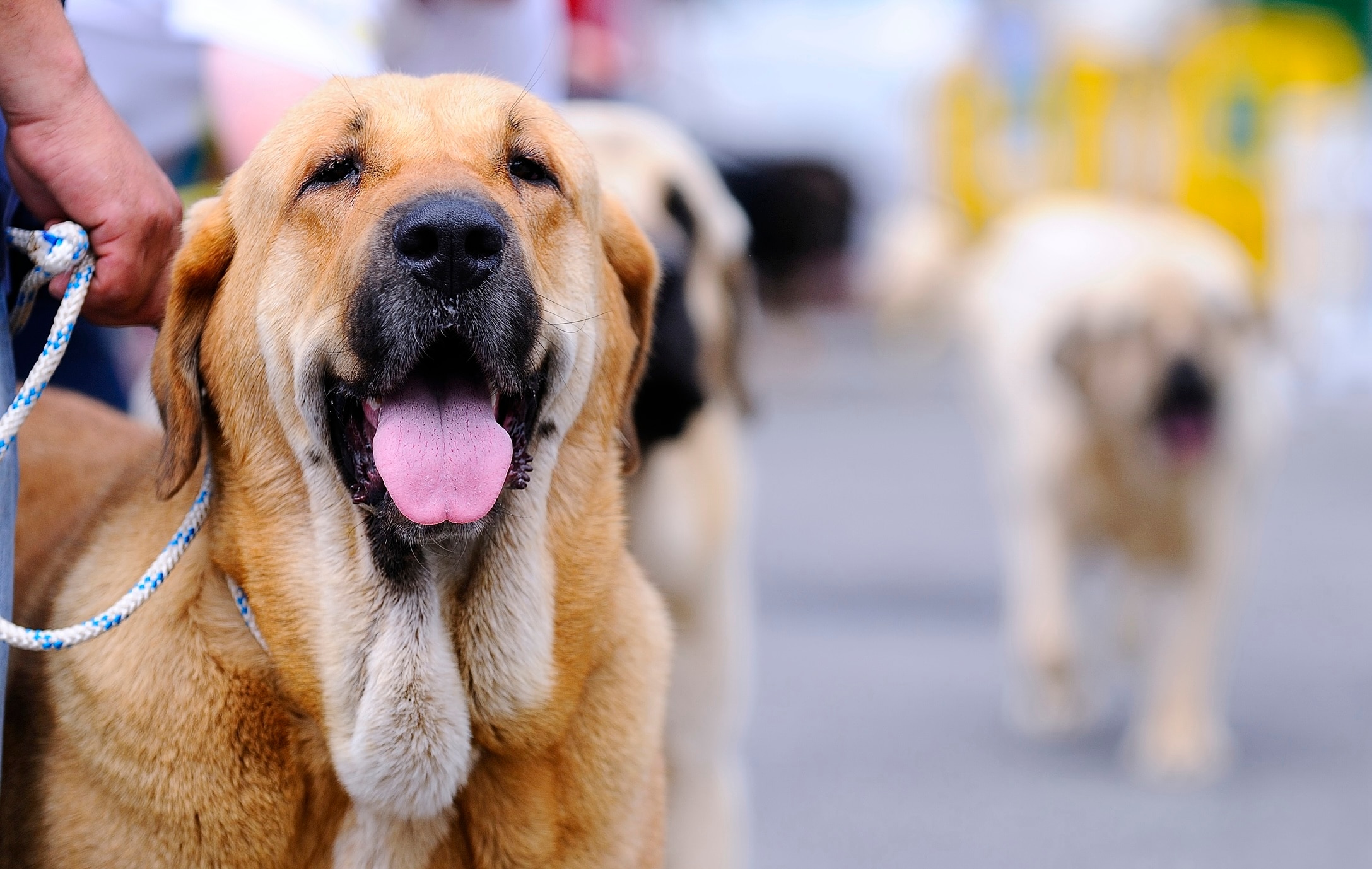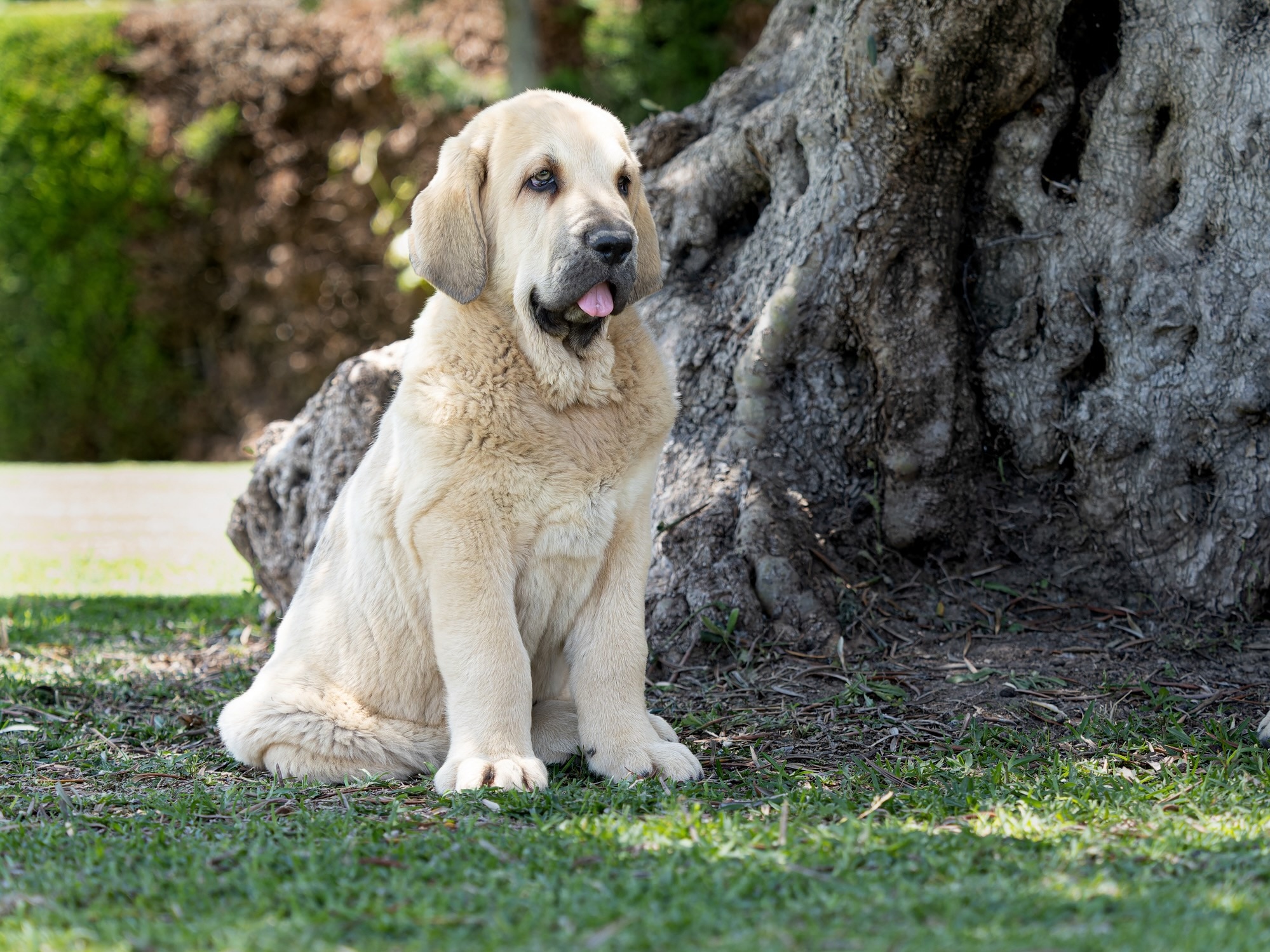Spanish Mastiff
Adobe Stock/Dixi_
Spanish Mastiffs, with their giant size and powerful bodies, have been used as livestock guardians for more than 2,000 years. Originally from Spain, the breed was tasked with protecting sheep from wolves and other predators—and one Spanish Mastiff dog was considered to be capable of looking after up to 100 sheep on their own, according to the American Kennel Club (AKC).
The Spanish Mastiff’s size is, at a minimum, 28–35 inches tall at the shoulder. These dogs can weigh 140–200 pounds.
Spanish Mastiffs are well-known for their large head, double dewlap (fold of loose skin) on their neck, and stocky but muscular body. This dog breed has a short dense coat that can be one of five colors—black, red, fawn, wolfgray, or yellow—with brindle or white markings.
Caring for a Spanish Mastiff
Spanish Mastiffs are affectionate with family members, but their guardian instincts may come into play when they’re around new people or in a new situation. They are good with young children and other dogs if properly socialized and trained as a puppy, but all interactions between kids and pets—no matter the breed—should be supervised.
Obedience training should be pursued when a Spanish Mastiff is young so they grow into a well-mannered dog. A Spanish Mastiff puppy needs to be trained to:
-
Remain calm around other animals, adults, and children
Spanish Mastiffs need about an hour of exercise every day, which can include a long walk, swim, or playtime in the house or a fenced yard. They do not make good running companions, however, because they don’t have the stamina to run long distances.
Spanish Mastiff Health Issues

The average Spanish Mastiff lifespan is 10–12 years, and the dogs can develop a handful of medical conditions over the course of their life.
Bloat and Gastric Dilatation-Volvulus
Deep-chested dogs such as the Spanish Mastiff are prone to bloat, which means their stomach fills with gas and suddenly makes their abdomen look distended. This condition is uncomfortable, but it’s treatable by placing a temporary tube to remove gas from the stomach.
Sometimes, however, bloat can lead to a life-threatening condition called gastric dilatation-volvulus (GDV). This occurs when a gas- or fluid-filled stomach twists, cutting off blood circulation to the stomach and other organs. GDV is an extremely painful condition that is fatal if emergency surgery is not immediately performed.
To minimize the risk of bloat and GDV in your Spanish Mastiff:
-
Have a prophylactic gastropexy (stomach tack) done at the time of your dog’s spay or neuter surgery
-
Feed your dog two to three meals a day, instead of one
-
Avoid using elevated food bowls
-
Prevent exercise one hour before and one hour after eating
Degenerative Myelopathy
Spanish Mastiffs with the genetic mutation for degenerative myelopathy develop muscle wasting in their back and limbs due to the spinal cord breaking down. This condition is similar to Lou Gehrig's disease (also known as amyotrophic lateral sclerosis, or ALS) in people.
Dogs with this condition drag their paws at first, but their mobility declines to the point that they become paralyzed in all four legs. There is no cure for this condition. Symptoms usually develop later in life, around 8–9 years of age.
Hip Dysplasia
Hip dysplasia is an inherited condition where the hip joint doesn’t properly align, causing pain and eventually arthritis. Some Spanish Mastiff puppies are born with congenital hip dysplasia, while others can develop this condition during their senior years.
Hip dysplasia can be managed with joint supplements and certain medications, but surgery may be required in serious cases.
What To Feed a Spanish Mastiff
Spanish Mastiffs should be fed a high-quality dog food for large or giant dog breeds. The food should also be formulated for their life stage (puppy, adult, or senior).
Your veterinarian can give you guidance on choosing the best food for your Spanish Mastiff. Make sure the diet meets the nutritional guidelines set by the Association of American Feed Control Officials (AAFCO); you can find this by looking for the AAFCO statement on the food packaging.
How To Feed a Spanish Mastiff
Spanish Mastiff puppies should be fed a large- or giant-breed puppy formula until they are 18–24 months old. Once fully grown, they need to transition to adult dog food to prevent unwanted weight gain.
To minimize risk of bloat or GDV, the following recommendations can help at mealtime:
-
Feed your dog two or three smaller meals a day, instead of one large meal
-
Avoid using elevated food bowls
-
Avoid exercise one hour before to one hour after a meal
-
Measure out meals, and do not overfeed your dog
-
Use a slow-feeder bowl if your Spanish Mastiff eats quickly
Again, it’s important that you don’t overfeed your Spanish Mastiff, as obesity can cause arthritis to develop within their joints early in life and lead to chronic mobility issues.
How Much Should You Feed a Spanish Mastiff?
Follow the feeding guidelines on your dog food packaging, and talk to your veterinarian to determine the correct portion size for your Spanish Mastiff. The right amount to feed your dog is based on their ideal body weight, life stage, and health.
Measure out the food for each meal to ensure you’re not overfeeding your dog. Obesity in dogs can lead to many health problems.
Nutritional Tips for Spanish Mastiffs
Healthy dogs eating an AAFCO-compliant food will receive all needed nutrients. But because full-grown Spanish Mastiffs weigh well over 140 pounds, your veterinarian may recommend giving your dog a joint supplement and an omega-3 fatty acid supplement (fish oil) to support the joints by minimizing inflammation.
Talk to your veterinarian before giving any supplements to your dog.
Behavior and Training Tips for Spanish Mastiffs
Spanish Mastiff Personality and Temperament

Spanish Mastiffs have a kind and calm temperament around family members, including children they know. However, they can be on guard around strangers, which is why socialization and training during puppyhood is crucial.
Many Spanish Mastiffs can live happily with other pets, including small dogs and cats, but they must be supervised and socialized with them starting at an early age. This breed is considered low-energy but does need about an hour of exercise every day.
Spanish Mastiff Behavior
Spanish Mastiffs are docile when they are around people and pets they know. They are not known to be anxious or fearful, but they will quickly become alert when a stranger or unfamiliar animal is nearby.
This breed does not bark a lot, but they will bark to alert loved ones of a possible threat—even if it’s just a delivery person. Their bark is low-pitched and deep, and can be heard from a distance.
Spanish Mastiff Training
The Spanish Mastiff dog breed is smart and can be difficult to train due to their desire to be independent. Because of this, Spanish Mastiffs may not be well-suited for first-time pet parents.
People with more experience training dogs are better equipped to make sure a Spanish Mastiff is trained properly. It’s best to start obedience training classes when your dog is young and use positive reinforcement. Seek a professional dog trainer if needed.
Fun Activities for Spanish Mastiffs
Spanish Mastiff Grooming Guide

Spanish Mastiffs have a short-haired double coat that requires a moderate amount of upkeep. Brushing your dog once a week with a pin brush can minimize shedding most of the year. But when their coat sheds heavily in the spring and fall, a deshedding rake is most useful.
Skin Care
The Spanish Mastiff has loose folds of skin on their neck due to the presence of their double dewlap. It’s important to check these folds for skin infections, as they can be prone to bacterial and yeast infections when moisture gets trapped inside.
Bathing your dog every six to eight weeks can be helpful to keep their coat clean, and check their skin folds for redness, crusts, odor, or moisture, which could be signs of infection.
Coat Care
Spanish Mastiff dogs shed year-round, more heavily in the spring and fall. Weekly brushing with a pin brush and comb are best when shedding is mild. During the shedding seasons, a deshedding rake should be used once to twice weekly to minimize the fur shed indoors.
This breed does not require a professional groomer, nor is their coat at risk for matting.
Eye Care
Compared to other mastiff breeds, Spanish Mastiffs are at less risk for entropion, a medical condition in which an eyelid rolls inward toward the eye. However, if you notice a lot of tearing from one or both eyes, please have your local veterinarian perform an eye exam.
Ear Care
Spanish Mastiffs have large ear canals, which can make them prone to ear infections. Cleaning their ears with an ear cleaner every two to three weeks—and after baths or swimming—will help prevent infections.
Considerations for Pet Parents
Spanish Mastiffs can be great family companions—for the right family.
Due to their massive size, they might not be a good fit for an apartment, condo, or townhouse. They do best living in a large home that has a fenced backyard or on a farm where they can run around.
Because this breed can have an independent spirit, Spanish Mastiffs are not a good choice for a first-time pet parent. Pet parents with dog training experience are better fit to take on this breed. Enrolling a Spanish Mastiff puppy in obedience training and socialization classes is important to help them become calm and well-mannered when fully grown.
Spanish Mastiffs are considered to have low energy. They enjoy a long walk, swim, or playtime in the backyard to get some exercise, but they prefer to lie around for most of the day.
Their grooming needs are considered moderate, as this breed does shed throughout the year. Brushing them at least once weekly is key to minimizing the fur balls inside your home. Their coat is short and not prone to matting, and a bath is needed occasionally when their coat appears dirty.
Spanish Mastiff FAQs
Is a Spanish Mastiff a good family dog?
Yes, a Spanish Mastiff can be a wonderful addition to a family. This breed is loving, and does well with children and other pets if properly trained and socialized at a young age.
Do Spanish Mastiffs bark a lot?
No, Spanish Mastiffs only bark when they want to alert a family member.
How much does a Spanish Mastiff cost?
A Spanish Mastiff puppy costs, on average, $2,500–$3,000.
How big does a Spanish Mastiff get?
A female Spanish Mastiff can weigh up to 170 pounds, while a male can weigh a whopping 220 pounds.
